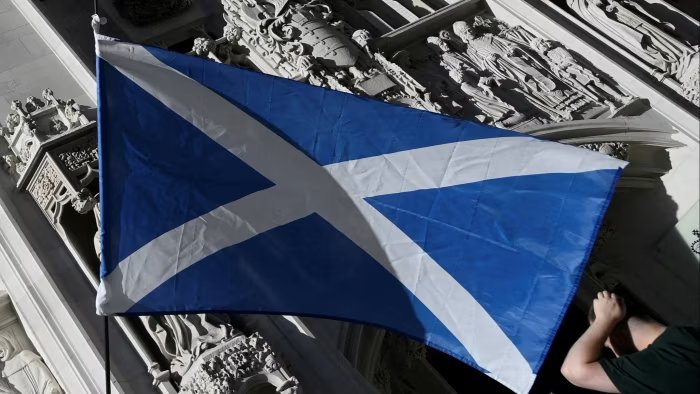Unlock the Editor’s Digest for free
Roula Khalaf, Editor of the FT, selects her favourite stories in this weekly newsletter.
Scotland has been handed the same credit rating as the UK, in a boost to Edinburgh as it plans an inaugural bond sale.
Moody’s and S&P Global late on Wednesday awarded the Scottish government investment-grade ratings of Aa3 and AA, respectively.
The assessments by major rating agencies clears the way for Scotland to issue its own bonds — nicknamed “kilts” — in the first quasi-sovereign issuance by Edinburgh since the late 17th century.
The ruling Scottish National party has characterised bond sales as a way of building credibility with financial markets in its push for independence and funding infrastructure investment.
An SNP majority at Holyrood parliamentary polls in May would provide a mandate for a second independence referendum, First Minister John Swinney has said.
Shona Robison, finance secretary, said the ratings reflected the government’s responsible debt and financial management. “High credit ratings will support our wider efforts to boost economic growth,” she said. Swinney would on Thursday provide an update on progress towards issuing a Scottish bond, she added.
Both agencies said their ratings were underpinned by the UK’s devolution framework, which means Scotland receives the majority of its funding from central government.
Both also referred to Scotland’s “prudent” fiscal policies. Its “very low debt levels” were supported by the nation’s “exceptional intrinsic liquidity position” through funding from the UK Treasury, S&P said.
The rating could be lowered if Scotland took “material steps” towards independence from the UK, the likelihood of which was “low”, the agency added. Moody’s also said independence “could exert downward pressure” on Scotland’s rating.
Moody’s added that “Scotland’s very low debt burden . . . is a key credit strength”, but warned that the country “faces budgetary pressures from a population that is ageing faster than the UK’s”. If unaddressed, the impact of this on the public finances “will start putting pressure on Scotland’s credit profile”, it said.
Scotland has been able to issue bonds since 2015, under legislation in the wake of the previous year’s independence referendum that gave the country’s devolved government wider borrowing powers. However, limits imposed by Westminster mean bond sales would contribute only a tiny part of Holyrood’s overall budget.
Even so, “kilt” sales would be an important symbolic step. In the late 17th century the ill-fated Company of Scotland Trading to Africa and the Indies raised a huge amount of funds from the public. Losses from this venture helped lead to the Acts of Union of 1707 that unified the English and Scottish kingdoms, after which Westminster became responsible for debt issuance.
Despite attracting a credit rating in line with the wider UK, Scotland is likely to have to pay higher interest costs to sell debt compared with those in the UK gilt market.
That is partly because the new market would be small compared with the £2.5tn in outstanding UK government bonds, making the bonds harder to trade than gilts.
Investors would “invest in kilts if they had a decent yield pick-up over gilts”, said Mike Riddell, a fund manager at Fidelity International.
Such a premium is evident in the bonds such as those issued by Network Rail, the owner of the UK’s rail infrastructure, which comes with the backing of the UK government. Local authorities around the world also typically borrow at a higher interest rate than their central government.
Achieving a credit rating to raise Scotland’s profile in international capital markets was a recommendation of the government’s independent investor panel, which reported in 2023 on how Scotland could attract investment to fund infrastructure.
“Although it will involve additional costs, Scotland’s profile could be significantly raised in the international capital markets by using existing devolved powers to issue debt,” said the panel, which was co-chaired by the first minister and Angus Macpherson, an investment banker.
It would allow Scotland to market its investment story through “regular engagement” with investors and building a “track record”, the panel added.
A move to sell kilts comes at a time when the strength of global demand for long-term borrowing has been under question, with issuance among rich nations expected to hit a fresh record this year.
Ten-year UK bond yields hit a 16-year high in January above 4.9 per cent as worries over the country’s debt dynamics added to a global sell-off. But they have since dropped back to below 4.5 per cent, helped by growing expectations of Bank of England interest rate cuts.
The Scottish government can borrow up to £472mn for capital investment in 2025-26 under limits set by a 2023 fiscal framework agreement. That would increase borrowing to 87 per cent of an overall £3.1bn debt cap, according to the Institute for Fiscal Studies.
Until now, Edinburgh has taken on debt via a facility called the National Loans Fund, which allows Scotland to access general UK government borrowing at the same interest costs as the Treasury.
In 2024-25, the Scottish government drew down £139mn from the fund at a 15-year maturity with an interest rate of 4.47 per cent.


